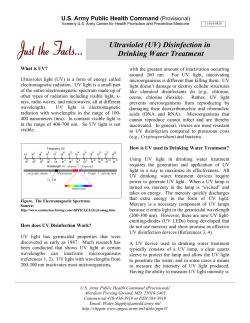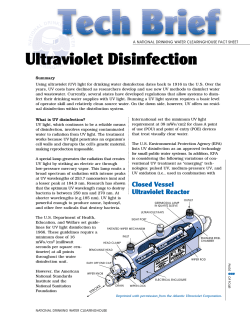
Ozone Disinfection
Ozone Disinfection Project funded by the U.S. Environmental Protection Agency under Assistance Agreement No. CX824652 What is disinfection? WWFSGN100 Fact Sheet Human exposure to wastewater discharged into the environment has increased in the last 15 to 20 years with the rise in population and the greater demand for water resources for recreation and other purposes. Disinfection of wastewater is done to prevent infectious diseases from being spread and to ensure that water is safe for human contact and the environment. There is no perfect disinfectant. However, there are certain characteristics to look for when choosing the most suitable disinfectant: • ability to penetrate and destroy infectious agents under normal operating conditions; • lack of characteristics that could be harmful to people and the environment; • safe and easy handling, shipping, and storage; • absence of toxic residuals, such as cancer-causing compounds, after disinfection; and • affordable capital and operation and maintenance (O&M) costs. This fact sheet was developed by Clement Solomon, Peter Casey, Colleen Mackne, and Andrew Lake. ©1998 by the National Small Flows Clearinghouse ETI Environmental Technology Initiative What are the advantages and disadvantages of using ozone disinfection? Advantages • Ozone is more effective than chlorine in destroying viruses and bacteria. • The wastewater needs to be in contact with ozone for just a short time (approximately 10 to 30 minutes). • Ozone decomposes rapidly, and therefore, it leaves no harmful residual that would need to be removed from the wastewater after treatment. • There is no regrowth of microorganisms after ozonation, unlike ultraviolet and chlorine disinfection. • Ozone is generated onsite, and thus, there are fewer safety problems associated with shipping and handling. • Ozonation increases the dissolved oxygen (DO) concentration of the discharged wastewater. The increase in DO can improve the oxygen content of the receiving body of water. What is ozone disinfection? Disadvantages One common method of disinfecting wastewater is ozonation (also known as ozone disinfection). Ozone is an unstable gas that can destroy bacteria and viruses. It is formed when oxygen molecules (O2) collide with oxygen atoms to produce ozone (O3). Ozone is generated by an electrical discharge through dry air or pure oxygen and is generated onsite because it decomposes to elemental oxygen in a short amount of time. After generation, ozone is fed into a down-flow contact chamber containing the wastewater to be disinfected. From the bottom of the contact chamber, ozone is diffused into fine bubbles that mix with the downward flowing wastewater. See Figure 1 on page 2 for a schematic of the ozonation process. Ozone disinfection is generally used at medium- to large-sized plants after at least secondary treatment. Another common use for ozone in wastewater treatment is odor control. • Low dosages may not effectively inactivate some viruses, spores, and cysts. • Ozonation is more complex than other disinfection technologies. • Ozone is very reactive and corrosive, thus requiring corrosion-resistant material, such as stainless steel. • Ozonation is not economical for poor quality (poorly treated) wastewater. • Ozone is extremely irritating and possibly toxic, so off-gases from the contactor must be destroyed to prevent worker exposure. • The cost of treatment is relatively high, being both capital- and power-intensive. • There is no measurable residual to indicate the efficacy of ozone disinfection. A General Overview What determines the performance of ozone disinfection? The primary way that ozone disinfects is through oxidation. The effectiveness of the ozonation process depends on: • how susceptible the bacteria, viruses, and other microorganisms are to the ozone, continued— Ozone Destruction Off-Gases Recycle Feed Gas Preparation • Oxygen Production • Oxygen Storage • Air/Oxygen Treatment Ozone Generation Discharge Ozone Contact Basin Wastewater In Figure 1: Ozone Disinfection Process Diagram Adapted from: U.S. Environmental Protection Agency (1986) • the amount of time the microorganisms in the wastewater are in contact with ozone, and • the concentration (dose) of the ozone. An ozone disinfection system strives for the maximum solubility of ozone in wastewater, as disinfection depends on the transfer of ozone to the wastewater. The off-gases from the contact chamber must be treated to destroy any remaining ozone before release to the atmosphere. Therefore, it is essential to maintain an optimal ozone dosage for better efficiency. Are ozone disinfection systems easy to operate and maintain? An ozonation system can be considered relatively complex to operate and maintain compared to chlorination. Ozone generation uses a significant amount of electrical power. Thus, constant attention must be given to the system to ensure that power is optimized for controlled disinfection performance. There must be no leaking connections in or surrounding the ozone generator. Therefore, leaks should be checked for routinely since a very small leak can cause unacceptable ambient ozone concentrations. The ozone monitoring equipment must be tested and calibrated as recommended by the equipment manufacturer. Like oxygen, ozone has limited solubility and decomposes more rapidly in water than in air. This factor, along with ozone’s reactivity, requires that the ozone contactor be well covered and have multiple diffusers to maximize ozone contact with the wastewater. In gaseous form, ozone will remain hazardous for a significant amount of time; thus, extreme caution is needed when operating ozone gas systems. It is important that the ozone generator, distribution, contacting, off-gas, and ozone destructor inlet piping be purged before opening the various systems or subsystems. What is the cost of ozone disinfection? The cost of ozone disinfection systems depends on the manufacturer, the site, the capacity of the plant, and the characteristics of the wastewater to be disinfected. Ozone disinfection is relatively expensive, with the cost of the ozone generation 2 Ozone Disinfection equipment being the primary capital cost item, especially since the equipment should be sized for the peak hourly flow, as with all disinfection technologies. Operating costs can also be very high depending on power costs, since ozonation is a power-intensive system. Because the concentration of ozone generated from either air or oxygen is so low, the transfer efficiency to the liquid phase is a critical economic consideration. For this reason, the contact chambers used are usually very deep and covered. How do I stay informed about ozonation technology? For more information on ozone disinfection or a list of other fact sheets, contact the National Small Flows Clearinghouse (NSFC) at West Virginia University, P.O. Box 6064, Morgantown, WV 26506-6064. Phone: (800) 624-8301 or (304) 293-4191. Fax: (304) 293-3161. World Wide Web site: http://www.nsfc.wvu.edu. The NSFC provides free and low-cost informational services and products to help homeowners and small communities address their wastewater needs. Also, information about manufacturers, consultants, regulations, and facilities can be obtained from the NSFC’s databases. References Crites, R. and G. Tchobanoglous. 1998. Small and Decentralized Wastewater Management Systems. The McGraw-Hill Companies. New York, New York. Metcalf & Eddy, Inc. 1991. Wastewater Engineering: Treatment, Disposal, and Reuse. 3d ed. The McGraw-Hill Companies. New York, New York. Rudd, T. and L. M. Hopkinson. December 1989. “Comparison of Disinfection Techniques for Sewage and Sewage Effluents.” Journal of International Water and Environmental Management. vol. 3. pp. 612–618. Task Force on Wastewater Disinfection. 1986. Wastewater Disinfection. Manual of Practice No. FD-10. Water Pollution Control Federation. Alexandria, Virginia. U.S. Environmental Protection Agency (EPA). 1986. Design Manual: Municipal Wastewater Disinfection. EPA Office of Research and Development. Cincinnati, Ohio. EPA/625/1-86/021. Water Environment Federation (WEF). 1996. Operation of Municipal Wastewater Treatment Plants. Manual of Practice No. 11. 5th ed. vol. 2. WEF. Alexandria, Virginia. The mention of trade names or commercial products does not constitute endorsement or recommendation for use by the NSFC or U.S. EPA.
© Copyright 2025





















